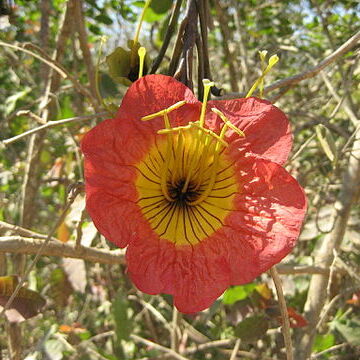Trees. Leaves 1-pinnately compound; leaflets 2-5(or 6) pairs. Inflorescences cymose, terminal or axillary, pubescent. Calyx tubular or campanulate, usually 2-5-lobed, subzygomorphic or regular, persistent. Corolla funnelform or campanulate; lobes 5, subrounded, sinuate or crenate. Stamens 4, didynamous; anthers 2-celled, slightly divergent, included; staminodes small. Disc annular, occasionally dentate. Ovary terete, glabrous or pubescent, 2-locular; ovules numerous, in 2 rows. Capsule dehiscing loculicidally, 4-angular; valves thin leathery; septum thick, smooth, vertical with fruiting valve. Seeds in 2 rows, numerous, nearly square, narrowly membranous winged at both ends.
Leaves caducous, imparipinnate, opposite, Flowers large, in short few-flowered racemes or solitary, borne praecociously and in axils of fallen leaves.
Calyx campanulate irregularly lobed, opening just before the corolla anthesis.
Capsule subcylindrical, dehiscing at right angles to the thin flat septum.
Ovary cylindrical, narrow, bilocular; ovules pluriseriate in each locule.
Stamens 4, slightly exserted; staminode 1; anther-thecae divaricate.
Corolla broadly cup-shaped, tube short, limb slightly bilabiate.
Seeds numerous, winged.
Shrubs or trees.
Disk cupular.

